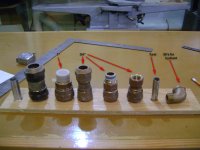the old grind
Elite Member
- Joined
- Jul 21, 2012
- Messages
- 4,412
- Location
- Mid-Michigan
- Tractor
- NH T-1520 HST, NH TC33DA HST, Case DX26 HST, .Terramite T5C, . NH L785
Copper holds up underground? I figured since copper pipe is not supposed to be run underground there was a corrosion issue. Or is that just costal areas that you can't run copper underground?
Good question, IMO. :thumbsup: There are several copper types, with color-coded labeling. 'L' (blue) is rigid and used for commercial supply where required by code. 'M' (red) is thinner-walled and what's typically used (or was) for residential supply. Both are copper alloys and too brittle for U/G use. (lacking ductility)
'K' (green label) is used for underground here in MI. It is nearly pure copper, thickest, resilient, and by far the priciest. It's bought rolled vs in straight sections and flare vs sweat fittings are used. (DWV [yellow or orange 'stripe'] is the thinnest of the rigid, soldered copper 'pipes'.)
Copper's recent cost is leading to alternatives nowadays, but recognize that electrical grounding rods are still copper or copper-plated steel vs say even pricier stainless steel (even more SS alloys in common use).
Some of our residential build and add-on customers don't understand why we prefer to use PEX vs copper for all supply lines, besides the cost saving. It doesn't work harden like 'hard' copper ('L' & 'M') by temperature variations, doesn't corrode, and ... won't get stolen.
IMO it's still much tougher U/G than PB (black poly), and should add that the last re-dig of barn supply (1 1/4" PB) was for a leak caused by poor forming and a weak 'stripe' along several feet of a section that we had to replace. Never seen such irregularity or inconsistency with PEX, so it remains my #1 choice in all (non-industrial) applications. tog

